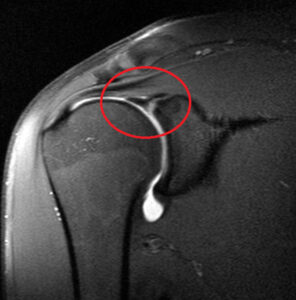SLAP Tear Surgery
Last Updated on August 12, 2024 by The SportsMD Editors
A SLAP tear is generally classified 1-4 depending on the extent of the tear and the involvement of the biceps tendon, which attaches to the superior aspect of the glenoid labrum. The most common type of SLAP tear is a type II. Although type III and IV tears are more involved, this does not necessarily correspond to injury severity and recovery. SLAP stands for Superior Labrum Anterior Posterior and refers to a specific type of labral tear in the shoulder. The tear is located at the top of the glenoid (superior) and extends from the front (anterior) to the back (posterior) of the glenoid.
SLAP Tear Causes
The cause of a SLAP tear can generally be divided into acute traumatic events or chronic repetitive injuries that lead to failure. An example of an acute traumatic event would be a fall onto an outstretched arm, which may result in SLAP lesion secondary to abnormal contact between the humeral head and the superior labrum/biceps anchor. One of the most chronic repetitive injuries that leads to a SLAP tear is overhead throwing. Overhead athletes, especially baseball pitchers, place huge amounts of stress on the shoulder with every throw. The position of external rotation just before ball release can overstress the attachment of the biceps tendon and can lead to a SLAP tear.
Symptoms of SLAP tear
Much like other types of labral tears, a SLAP tear is often accompanied by pain deep in the shoulder, popping or clicking in the shoulder, and a decreased range of motion or strength. The symptoms are often made worse with shoulder movements, most often overhead activities such as throwing. Patients may also have feelings of instability (i.e. the shoulder is going to pop out of place). It is often hard to pinpoint symptoms, unless the biceps tendon is also involved. In cases of SLAP tears with associated biceps tendonitis, patients may complain of pain over the front of the shoulder.
When should I see a doctor?
Any patient with significant pain and disability after a fall onto a shoulder should see a physician as soon as possible. In addition, athletes who participate in overhead sports and have persistent shoulder pain and disability despite rest, ice, and anti-inflammatory medication are also advised to see a physician as soon as possible. It is important to note that many patients with SLAP tears do not complain of the classic symptoms of shoulder clicking or popping; pain may be the only symptom. Also it is not uncommon to have pain only when using the shoulder, particularly during throwing activities.
Diagnosis of SLAP tear
An experienced clinician will obtain a thorough history and perform a physical examination to help determine whether or not you have a SLAP tear. There are several specific physical examination maneuvers that are often used to detect a SLAP tear. However, the ability of these tests to accurately detect a SLAP tear can vary from patient to patient.
SLAP Tear MRI

Most clinicians will obtain an advanced imaging test, such as an MRI, to help diagnose a SLAP tear. Your physician may or may not require the use of contrast in the MRI to help delineate the SLAP lesion. Sometimes the SLAP tear does not even show up well on MRI, and the diagnosis is made at the time of surgery if the clinician has a strong suspicion. It should be noted that plain radiographs or x-rays play little role in helping make the diagnosis, but most doctors obtain them to assess your bone architecture.
Treatment for SLAP Tear
There are several key factors that play a role in the decision-making process regarding treatment for SLAP Tear. These include your age, type of SLAP tear, and athletic profile. Most physicians will try conservative management first (meaning non-operative) which consists of a period of rest, ice, and anti-inflammatory medications followed by a course of physical therapy. Some clinicians will recommend immediate surgery for patients with SLAP tears and significant other shoulder pathology, most notably shoulder instability and rotator cuff tears.
More Information: Read about sports injury treatment using the P.R.I.C.E. principle – Protection, Rest, Icing, Compression, Elevation.
When these treatments fail, arthroscopic surgery of the shoulder is typically recommended. It is important to keep in mind that it is not uncommon to have a SLAP tear in conjunction with other shoulder pathology. Therefore any surgical procedure will have to address all of the pathologies that the clinician encounters.
SLAP Tear Surgery – Three options
1) Debridement:
The torn labral tissue is shaved away to leave a smooth edge. This option is only suitable for stable SLAP lesions that do not involve the biceps tendon. (i.e. Type I and III)
2) Repair:
A SLAP repair is an arthroscopic procedure that uses anchors with sutures attached to secure the torn labrum down to the shoulder socket. A SLAP repair is the most common procedure done for symptomatic SLAP lesions and is reserved for young patients with an otherwise healthy shoulder who want to remain athletically active.
3) Biceps tenodesis:
A biceps tenodesis is a procedure that cuts the biceps tendon from where it attaches to the labrum, and reattaches it to another area. The idea behind a biceps tenodesis is that by decreasing the forces that pull on the SLAP region, the symptoms will be alleviated. A biceps tenodesis is most often performed on patients over 40 years of age or patients with extensive biceps tendonitis or tearing. The decision on whether or not to perform a biceps tenodesis is often made during the time of surgery. A biceps tenodesis can either be performed arthroscopically, or through a small incision. This decision is often entirely based on surgeon preference since both techniques have good results.
Get a Virtual Sports Specialized appointment within 5 minutes for $29
 When you have questions like: I have an injury and how should I manage it? How severe is it and should I get medical care from an urgent care center or hospital? Who can I talk to right now? SportsMD Virtual Urgent Care is available by phone or video anytime, anywhere 24/7/365, and appointments are within 5 minutes. Learn more via SportsMD’s Virtual Urgent Care Service.
When you have questions like: I have an injury and how should I manage it? How severe is it and should I get medical care from an urgent care center or hospital? Who can I talk to right now? SportsMD Virtual Urgent Care is available by phone or video anytime, anywhere 24/7/365, and appointments are within 5 minutes. Learn more via SportsMD’s Virtual Urgent Care Service.
How is a SLAP tear surgery performed?
After a diagnostic arthroscopy is completed, the SLAP tear is identified and any unstable tissue is shaved. Next, the superior aspect of the glenoid is shaved to produce mild bleeding to encourage healing. A suture anchor is placed at this location and the sutures from the anchor are used to firmly tie down the labrum back to its anatomic location. It may be necessary to perform this several times depending on the tear.
What are the advantages of each procedure?
The advantage of a SLAP repair is that it restores the normal anatomy of the superior labrum/biceps anchor complex. As a result, once the SLAP tear has healed, there is normal function of the previously damaged labrum and biceps attachment. This is important in young patients who will depend on their shoulder for athletic activity over several years. The advantage of a simple debridement or biceps tenodesis is that the postoperative recovery is not as restrictive and not as long.
Slap Tear Surgery recovery
The exact steps in this process are determined by the type of extent of the SLAP lesion and how much other damage was present. Most patients will be maintained in a sling with minimal activity for about six weeks following a SLAP repair. During this first phase of rehabilitation, some passive motion is allowed to prevent shoulder stiffness. At 6 weeks, a formal physical therapy program is begun that focuses on restoring range of motion first and ultimately shoulder strength. Generally speaking, a full return to athletic activity can be started at 3-4 months for noncontact sports and 6 months for contact sports.
SLAP Tear surgery success rate
Young individuals and athletes have a good record of SLAP tear surgery success rate with a return to full range of motion and sports activities. But over the last several years, there has been an increase in SLAP tears in older patients or those over 40 years old.
Aman Dhawan, MD, Penn State Bone and Joint Institute and his colleagues conducted a comprehensive study on the success rate of SLAP tear surgery. The findings indicate that compared to younger patients, those over 40 years of age who undergo arthroscopic SLAP repair are more likely to experience post-repair complications. Complications often experienced include pain and stiffness, and this group of patients has a higher likelihood of undergoing revision surgery. The risk of surgery complications increases with patient age and is three times higher in patients over 40 as compared to those younger.
Questions and Answers
When discussing SLAP (Superior Labrum Anterior and Posterior) tear surgery with a healthcare provider, it’s important to ask questions to fully understand your condition and treatment options. Here are some questions you can ask, along with potential answers:
- What is a SLAP tear?
- A SLAP tear is an injury to the labrum in the shoulder joint, specifically the superior (top) portion. The labrum is a ring of cartilage that helps stabilize the shoulder.
- How was the SLAP tear diagnosed in my case?
- Diagnosis often involves a physical examination, medical history, and imaging studies like MRI.
- What caused my SLAP tear?
- SLAP tears can result from acute trauma, such as a fall or a sudden jerking motion, or from chronic wear and tear in athletes and those who perform repetitive overhead activities.
- Is surgery necessary for a SLAP tear?
- Whether surgery is required depends on the severity of the tear, your age, activity level, and the goals of treatment. Some SLAP tears can be managed non-surgically, while others may require surgery.
- What are the treatment options for a SLAP tear?
- Treatment options include rest, physical therapy, activity modification, and surgery to repair or reattach the labrum.
- What does SLAP tear surgery involve?
- SLAP tear surgery typically involves an arthroscopic procedure where small incisions are made, and a camera and surgical instruments are used to repair or reattach the labrum.
- How long will the recovery process take, and what can I expect during this time?
- Recovery time varies based on the specific procedure and individual factors, but it typically takes several months. Physical therapy is usually required for rehabilitation.
- What are the potential complications associated with SLAP tear surgery and recovery?
- Complications can include infection, stiffness, or incomplete healing. Your doctor can provide more information.
- Do I need a follow-up appointment, and when should it be scheduled?
- Establish a plan for post-treatment follow-up appointments to monitor your progress and make any necessary adjustments to your care.
Always consult with your healthcare provider for personalized answers to these questions, and feel free to ask additional questions or seek clarification on any points you don’t fully understand. Effective communication with your doctor is essential for your understanding and overall care.
References:
- Dodson CC, Altchek DW. SLAP Lesions: An Update on Recognition and Treatment. JOSPT 2008; 39(2): 71-80.
- Andrews JR, Carson WG Jr, McLeod WD. The arthroscopic treatment of glenoid labrum tears in the throwing athlete. Orthop Trans 1984; 8:44.
- Coleman SH, Cohen DB, Drakos MC, et al: Arthroscopic repair of type II SLAP lesions with and without acromioplasty: a clinical analysis of 50 patients. Am J Sports Med 2007; 35(5): 749-753.

